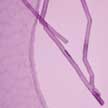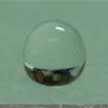Showing Spotlights 2729 - 2736 of 2836 in category All (newest first):
 A new method based on the nanoscale Kirkendall effect was demonstrated to fabricate compound nanotubes. Through a spinel-forming solid-state reaction, high aspect-ratio core-shell ZnO-Al2O3 nanowires transform into monocrystalline ZnAl2O4 nanotubes.
A new method based on the nanoscale Kirkendall effect was demonstrated to fabricate compound nanotubes. Through a spinel-forming solid-state reaction, high aspect-ratio core-shell ZnO-Al2O3 nanowires transform into monocrystalline ZnAl2O4 nanotubes.
Jul 14th, 2006
 Researchers at the University of Illinois at Urbana-Champaign have shown that, by employing small pieces of DNA molecules called aptamers, nanomaterials can be smart enough to assemble or disassemble only in the presence of programmable signals such as AND or OR, with controllable cooperativity.
Researchers at the University of Illinois at Urbana-Champaign have shown that, by employing small pieces of DNA molecules called aptamers, nanomaterials can be smart enough to assemble or disassemble only in the presence of programmable signals such as AND or OR, with controllable cooperativity.
Jul 13th, 2006
 In order to survive, biological systems need to form patterns and organize themselves. Scientists at the Max Planck Institute for Colloids and Interfaces (MPI-KG) in Potsdam, Germany, have now combined self-organization with chemical pattern formation. They demonstrated that oscillating reaction patterns like that of a Belousov-Zhabotinsky reaction can not only be generated in a one-phase system like in all previous examples but also in a two-phase system like liquid-solid.
In order to survive, biological systems need to form patterns and organize themselves. Scientists at the Max Planck Institute for Colloids and Interfaces (MPI-KG) in Potsdam, Germany, have now combined self-organization with chemical pattern formation. They demonstrated that oscillating reaction patterns like that of a Belousov-Zhabotinsky reaction can not only be generated in a one-phase system like in all previous examples but also in a two-phase system like liquid-solid.
Jul 12th, 2006
 Superhydrophobic surfaces, such as lotus leaves, with micro/nano combined structures found in nature have attracted a lot of interest because of their importance in fundamental research and practical applications such as self cleaning, anti-fogging/snowing, drag reduction effect etc. In this regard, diverse methods have been proposed to produce such surfaces. However, most of the reported methods in the literature generally require a cleanroom-based process or complex chemical processes and have some limitations in terms of mass-production capability and material selectivity.
Superhydrophobic surfaces, such as lotus leaves, with micro/nano combined structures found in nature have attracted a lot of interest because of their importance in fundamental research and practical applications such as self cleaning, anti-fogging/snowing, drag reduction effect etc. In this regard, diverse methods have been proposed to produce such surfaces. However, most of the reported methods in the literature generally require a cleanroom-based process or complex chemical processes and have some limitations in terms of mass-production capability and material selectivity.
Jul 11th, 2006
 The color of metal colloids is highly dependent on their size and therefore being able to control the size is very important to tune the metal colors systematically. By controlling the wavelength of optical resonance of metal nanoparticles and their composition, researchers in South Korea have found a way to fabricate various colored metal colloids both easily and reproducibly. These findings could be very useful for biological assays.
The color of metal colloids is highly dependent on their size and therefore being able to control the size is very important to tune the metal colors systematically. By controlling the wavelength of optical resonance of metal nanoparticles and their composition, researchers in South Korea have found a way to fabricate various colored metal colloids both easily and reproducibly. These findings could be very useful for biological assays.
Jul 10th, 2006
 You might think that with all the buzz that nanotechnology creates among insiders (mostly scientists) there would be a rising awareness and interest among the general public. Apparently not so. If internet search engines are an indication for the general interest then nanotechnology is not a big issue yet.
You might think that with all the buzz that nanotechnology creates among insiders (mostly scientists) there would be a rising awareness and interest among the general public. Apparently not so. If internet search engines are an indication for the general interest then nanotechnology is not a big issue yet.
Jul 7th, 2006
 Multidrug resistance, the principal mechanism by which many cancers develop resistance to chemotherapy drugs, is a major factor in the failure of many forms of chemotherapy. New research by Chinese scientists suggests that nanoparticle surface chemistry and size as well as the unique properties of the magnetic nanoparticles themselves may contribute to a synergistic enhanced effect of drug uptake of targeted cancer cells. These findings could result in promising biomedical applications for cancer therapy.
Multidrug resistance, the principal mechanism by which many cancers develop resistance to chemotherapy drugs, is a major factor in the failure of many forms of chemotherapy. New research by Chinese scientists suggests that nanoparticle surface chemistry and size as well as the unique properties of the magnetic nanoparticles themselves may contribute to a synergistic enhanced effect of drug uptake of targeted cancer cells. These findings could result in promising biomedical applications for cancer therapy.
Jul 6th, 2006
 The mass production of nanoelectronic devices has been hampered by difficulties in aligning and integrating the millions of nanotubes required for the job. Now, researchers in South Korea have developed a method to precisely assemble and align single-walled carbon nanotubes (SWCNTs) onto solid substrates without relying on external forces such as electric or magnetic fields. This result could be an important guideline for the large-scale directed-assembly of integrated devices based on SWCNTs.
The mass production of nanoelectronic devices has been hampered by difficulties in aligning and integrating the millions of nanotubes required for the job. Now, researchers in South Korea have developed a method to precisely assemble and align single-walled carbon nanotubes (SWCNTs) onto solid substrates without relying on external forces such as electric or magnetic fields. This result could be an important guideline for the large-scale directed-assembly of integrated devices based on SWCNTs.
Jul 5th, 2006
 A new method based on the nanoscale Kirkendall effect was demonstrated to fabricate compound nanotubes. Through a spinel-forming solid-state reaction, high aspect-ratio core-shell ZnO-Al2O3 nanowires transform into monocrystalline ZnAl2O4 nanotubes.
A new method based on the nanoscale Kirkendall effect was demonstrated to fabricate compound nanotubes. Through a spinel-forming solid-state reaction, high aspect-ratio core-shell ZnO-Al2O3 nanowires transform into monocrystalline ZnAl2O4 nanotubes.
 Subscribe to our Nanotechnology Spotlight feed
Subscribe to our Nanotechnology Spotlight feed
